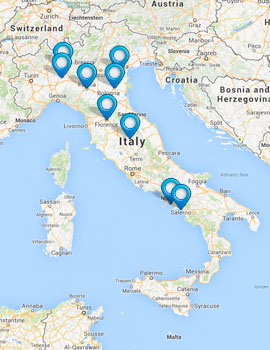
Phytolab, Department of Chemistry, University of Florence.
Prof A. R. Bilia, Dr. M. C. Bergonzi, C. Guccione
The research group of Prof. Anna Rita Bilia is interested towards the study of bioactive molecules from plant matrices. The group has a deep background in the analysis and pharmaceutical technology of herbal drugs, herbal drug preparations and herbal medicinal products. The main actual topics include the improvement of bioavailability and technological features applying pharmaceutical technology tools (liposomes, nanoparticle, supramolecular complexes, micelles) to the world of natural compounds.
Research topics can be summarized as follows:
1- Studies of pharmaceutical and technological aspects of herbal drugs, herbal drug preparations and herbal medicinal products including
1a-improvement of bioavailability and technological features of extracts and single isolated constituents. Design and development of innovative formulations using micro- and nanocarriers such as liposomes and vesicles, micelles, supramolecular complexes with cyclodextrins, nanocapsules and solid lipid nanoparticles. Characterisation of the micro- and nanocarriers by conventional methods (HPLC, DSC, UV, light scattering, dissolution tests, TEM) and innovative ones such as NMR (ROESY and DOSY).
1b-authentication, quality control and stability testing by using not only conventional but also unconventional methods such as 1D- and 2D- NMR, NIR, and biosensors
2-Isolation and structural determination of secondary constituents from plants.
The group has long worked for the development of artemisinin and artemisinin derivatives-based formulations to increase their bioavailability. Artemisinin is an endoperoxide sesquiterpene lactone isolated from Artemisia annua L. Its activity against severe and cerebral malaria is fully described in literature. Afterwards it has scarse biopharmaceutical properties, which limited its use. Liposomes were selected to formulate artemisinin. Artemisinin-loaded conventional and PEGylated liposomes were prepared according to the film hydratation method. The bioavailability of artemisinin and two different liposomal formulations was evaluated in healthy mice. Encapsulation efficacy was detected by HPLC/DAD/ESI MS, dimensional analysis by Dynamic Light Scattering and morphology by Trasmission Electron Microscopy.
Dihydroartemisin in is one of the most potent anticancer artemisinin-like compounds, able to induce cancer cell death by apoptotic pathways. Besides its effectiveness, it is a poorly water soluble drug with low bioavailability and low half-life (34–90 min), therefore, the development of new formulations of dihydroartemisinin to increase bioavailability is in great need. Conventional and stealth liposomes to deliver dihydroartemisinin to cancer cells were developed for the first time. Physical and chemical stabilities were evaluated under storage condition and in presence of albumin. Cellular uptake efficiency of liposomes was determined by flow cytometry.
The therapeutic efficacies of novel liposomal delivery systems based on artemisinin or ACTs (artemisinin-based combination therapies) with curcumin are also investigated. Prepared liposomal formulations have proper physical characteristics as drug carrier for parental administration in terms of particle size, polydispersity, encapsulation efficacy and ζ-potential. In addition, their physical and chemical stabilities were evaluated. Furthermore, the in vivo antimalarial activity of artemisinin-based liposomal formulations was tested in P. berghei NK-65 infected mice. Artemisinin, alone or in combination with curcumin, was encapsulated in conventional and PEGylated liposomes and its in vivo performance was assessed in comparison with free drug.
Microspheres curcumin-based able to incorporate azathioprine, useful for psoriasis treatment were also investigated. The preparation, characterization and in vitro activities were performed.
Salvianolic acid B (SalB)-loaded conventional and PEGylated liposomes were also characterised. SalB is a constituent of Salvia miltiorrhiza Bge. with a strong free radicals scavenger activity. In particular, SalB can protect against the oxidative stress as well as the antioxidant superoxide dismutase and reduce activity of glutathione, important determinants of neuropathological and behavioural consequences in neuropathic pain. Due to the poor chemical stability and bioavailability of SalB, liposomes were developed as drug carriers for its parental administration.
In the last three years, the group investigated also solid lipid nanoparticles (SLNs) and nanostructured lipid carrier (NLCs) for the encapsulation of curcumin for oral administration. Despite multiple health benefits, curcumin functionality for food fortification is strongly limited by its poor aqueous solubility and low oral bioavailability. High shear homogenization and ultrasonication technique was employed to prepare SLNs and NLCs. The physicochemical characterization of nanoparticles in terms of particle size, zeta potential, drug loading capacity, drug entrapment efficiency, TEM analysis and in vitro drug release, was carried out. Stability was investigated on storage conditions (4ºC) over one month. The Parallel Artificial Membrane Permeability in vitro Assay (PAMPA) showed a considerable increasing of the amount of curcumin permeated in the case of SLN and NLC suspensions if compared with the saturated solution of curcumin used as control.
Recently, to design novel fluorescent polymeric nanoparticles to target brain tissues and follow their in vivo distribution as new strategies to cross the blood brain barrier (BBB), polymeric nanoparticles are developped. Two innovative fluorescent nanospheres (NSs) were design: ethylcyanoacrylate-made NSs coated with polysorbate 80 and human serum albumin-made NSs. They were prepared by emulsion polymerization method and by coacervation method and thermal or chemical cross-linking with glutaraldehyde, respectively. NSs were characterized in terms of dimensional analysis, polydispersity and Zeta potential, morphology, encapsulation efficacy and loading capacity. Both NSs were injected intraperitoneally, intravenously and into the nucleus basalis magnocellularis of the basal forebrain of anaesthetized rats. NSs biodistribution was evaluated by fluorescent microscope images.
In the recent years the group evaluated the effect of micellar systems and cyclodextrins incapsulation on the solubility, bioavailability and stability of herbal drugs and herbal medicinal products.
The effect of micelles of SDS and octanoyl-6-O-ascorbic acid (ASC8) surfactants and cyclodextrin on the biopharmaceutical properties of Hypericum perforatum L. extract were studied. The aim of the work was to develop new oral formulations with a better pharmacokinetic, a more rapid onset and prolonged action with respect to the extract alone and to verify the possibility of reducing the dosage of total extract while obtaining the same antidepressant-like effect with minor potential side-effects. Finally, the influence of cyclodextrin and micelles on the solubility of the constituents of the extract within the formulations was evaluated to better elucidate the results obtained from the pharmacological tests.
A pharmacological approach, instead of the pharmacokinetic one, was used in order to evaluate the improvement of the properties of the new developed formulations. The mouse forced swimming test a behavioural model where antidepressant drugs clomipramine and amitriptyline are active, was used to test the antidepressant activity of the different dosage forms and the data was compared with those obtained with the widely used the dried extract.
The octanoyl-6-O-ascorbic acid was also used to protect all the characteristic constituents of Hypericum perforatum L., from oxidation processes. Given the intrinsic ability of octanoyl-6-O-ascorbic acid to form micelles, aqueous solubility of the constituents has also been increased. Thermal and photostability of commercial dried extract in the presence of octanoyl-6-O-ascorbic acid were evaluated according to the ICH test conditions.
In particular in recent years, the group investigated the interactions of some natural flavonols with natural cyclodextrins. Guest molecules were galangin, kaempferol and quercetin. Inclusion complexes were prepared by kneading and freeze-drying. The complexes were characterized using different physico-chemical methods based on differential scanning calorimetry (DSC), infrared spectroscopy (IR) and NMR spectroscopy. Moreover, the water-solubility of the flavonols in the presence of Cds was also evaluated.
It was also increased the solubility of Kavalactones. They are polar constituents, but poorly soluble in water with a low bioavailability. In the study, the formation of inclusion complexes of one of the most representative kavalactone isolated from kava–kava extract, (S)-7,8-dihydrokavain (DHK), with beta-cyclodextrin was investigated mainly by spectroscopic methods. NMR experiments were extensively used for the complete characterization of the complex and included 1H NMR complexation shifts analysis, 1HNMR diffusion measurements (DOSY), and ROESY experiments.






